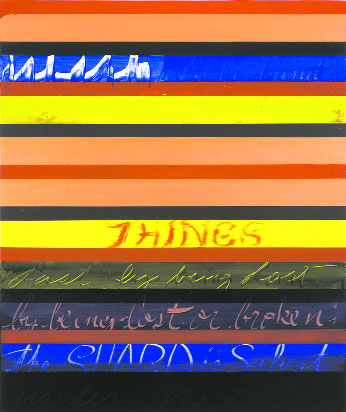Stephen Ellis articulates an argument that challenges commonplace cultural expectations
Jeremiah, of the 24th book of the Old Testament, was a seer who railed against sinners, priests, false prophets, kings, and generals, and was claimed by some to be a previous incarnation of Jesus Christ. And why has Stephen Ellis titled his current show of abstract paintings “Jeremiads?” What could Jeremiah have to do with contemporary art in 2003?
The notion that art is without politics is itself a political stance. The fact that our culture is so thoroughly inculcated with the idea of art that is free of politics is a victory of an atavistic, backward view. Creative thinking has been largely relegated to party tricks and crocodile tears—Jeremiah himself is mistakenly associated with the Book of Lamentation, and weeping. In truth, art, as the origin of language, is the most primary element of politics, and historically demonstrates itself to be just that, whether in the form of a new, insurgent written language invented by the ancient Hebrews, or an album by Public Enemy.
Here, we find the powerfully articulated, even gesticulated argument of Stephen Ellis. Bold, lush colors, very much out of a present-day milieu, stand on the brink of this impact between abstraction and pictogram, abstraction and language. Ellis’ work reflects the experience of all people struggling for modes of expression that reach beyond the language of their leaders and whose efforts are the essence of political evolution. The state of the world now, with the link between the promised land of America and the promised land of the Middle East, points up the enduring need for people to relate in manners beyond the strictures of rhetoric based in reticence.
It is a difficult time for artists—the narrowness of their cultural license to participate, the limitation of the resources available to them—and Ellis is unassailable in his assertion that creative thinking, whatever that thought process ultimately puts forth, is social activism. Electric blue expanses and color palettes of vibrating intensity all seem to compete directly with our commonplace cultural expectations, in particular with that of another holiday season. And why not, Ellis asks, why not, this winter solstice, forgo the crèche, and hang the work of a contemporary artist instead?


































